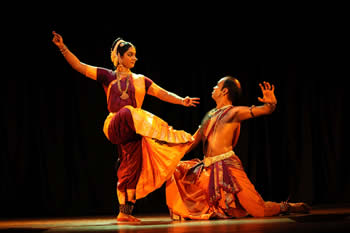Difference between Bharatanatyam and Kuchipudi Dance
Key Difference: Bharatanatyam developed in Tamil Nadu, Kuchipudi developed in Andhra Pradesh. Originally, Kuchipudi would be performed by all-male groups, with each person depicting a different character. Bharatanatyam, on the other hand, has always been performed by female dancers, who would dance at the temples in honor of the gods.
 Bharatanatyam and Kuchipudi are two different dances that have originated in India. They are two of the eight generally accepted Indian Classical Dances. Both Bharatanatyam and Kuchipudi developed in South India as different types of temple dances. Bharatanatyam developed in Tamil Nadu, Kuchipudi developed in Andhra Pradesh. These dances were originally performed in temple for the purpose of honoring the gods and highlighted the religious themes and spiritual ideas. However, while Bharatanatyam continued to primarily be a temple dance, Kuchipudi evolved to dance out plays and stories.
Bharatanatyam and Kuchipudi are two different dances that have originated in India. They are two of the eight generally accepted Indian Classical Dances. Both Bharatanatyam and Kuchipudi developed in South India as different types of temple dances. Bharatanatyam developed in Tamil Nadu, Kuchipudi developed in Andhra Pradesh. These dances were originally performed in temple for the purpose of honoring the gods and highlighted the religious themes and spiritual ideas. However, while Bharatanatyam continued to primarily be a temple dance, Kuchipudi evolved to dance out plays and stories.
Travelling bards would use this dance form to tell the stories of Krishna to various audiences as they travelled around the country in all-male troups. They would often perform on a stage adjacent to a temple. Over time, they started to adapt other stories as well. In modern adaptation, a single dance can also perform Kuchipudi purely as a dance, rather than to depict a story. Alternately, the dancer can also depict the story of a single character.
Originally, Kuchipudi would be performed by all-male groups, with each person depicting a different character. Female roles would often be played by men. However, overtime more and more women broke into the art and today they outnumber the men. In fact, in many instances women today must play the male role in the drama due to the limited availability of male Kuchipudi dancers.
Bharatanatyam, on the other hand, has always been performed by female dancers, who would dance at the temples in honor of the gods. This tradition has continued over time and Bharatanatyam is still performed primarily by women, with men dancers being rare.
 Both Bharatanatyam and Kuchipudi, along with all other forms of temple dances were banned in 1910 in the Madras Presidency of the British Empire. The ban came after a long smear campaign against these dances spearheaded by Christian missionaries and British officials who called these Indian classical dances as evidence of "harlots, debased erotic culture, slavery to idols and priests" tradition. They labeled the dancers as “nautch-girls” and prostitutes and accused the dances as being a front for prostitution despite there being no evidence other than cultural prejudice.
Both Bharatanatyam and Kuchipudi, along with all other forms of temple dances were banned in 1910 in the Madras Presidency of the British Empire. The ban came after a long smear campaign against these dances spearheaded by Christian missionaries and British officials who called these Indian classical dances as evidence of "harlots, debased erotic culture, slavery to idols and priests" tradition. They labeled the dancers as “nautch-girls” and prostitutes and accused the dances as being a front for prostitution despite there being no evidence other than cultural prejudice.
However, the ban had the opposite effect. Afraid of their culture and identity being repressed and lost forever, a massive revival was put into plan to preserve and reinvigorate the culture leading to a period of renaissance for these classical Indian dances. This led them to become more popular than they ever were, going as far as developing a name for the Indian arts internationally.
As dances, Bharatanatyam and Kuchipudi are quite similar in nature. So much so that a layman might even deem them the same when performed for him. The coustumes are quite similar with the women wearing a form fitting sari with a pleated fan to highlight their footwork. This is paired with heavy traditional jewelry and heavy makeup, especially around the eye to highlight the eye movements and other facial expressions. The men in Kuchipudi were a simple dhoti with some jewelry and makeup, reminiscing of the traditional male costumes.
In both Bharatanatyam and Kuchipudi, the dancers primarily utilize the half seating position or a partial squat form called the Ardhamandali, with the legs bent or knees flexed out. The emphasis is placed on the footwork with special emphasis on the various hand mudras and eye and facial expressions which are used to depict the expressions of the characters.
While both are danced to classical Carnatic music, the difference is that in Kuchipudi, the dane is often accompanied with a singer singing in Telugu, who will depict the story of the play or the character. The dance will ideally lip-sync the song, in accordance with the tradition where the dancer would sing their characters parts while dancing. In Bharatanatyam, there may or may not be a singer accompanying the dance, and the dancer will usually not lip-sync the song.
Comparison between Bharatanatyam and Kuchipudi Dance:
|
|
Bharatnatyam |
Kuchipudi |
|
Existed since |
2nd century CE |
At least back to 10th century CE Modern version dates back to 17th century |
|
Etymology |
Bha stands for bhava (feelings, emotions), ra stands for raga (melody, framework for musical notes), and ta stands for tala (rhythm). Natyam is Sanskrit for “dance”. |
Named for the village, Kuchipudi, short for Kuchelapuram or Kuchilapuri, in which the dance developed. From Sanskrit Kusilava-puram, which means "the village of actors" |
|
Also known as |
Sadir, Daasiyattam |
- |
|
Transcribed in |
Written in Natya Shastra compilation by ancient scholar Bharata Muni, dated to between 200 BCE and 200 CE |
Written in Natya Shastra compilation by ancient scholar Bharata Muni, dated to between 200 BCE and 200 CE |
|
Passed down as |
Guru-Shishya (Teacher-Student). Teachings from masters to students in various dance schools. |
Guru-Shishya (Teacher-Student) leading to several regional banis (styles) depending on the gurus (teachers). |
|
Region |
South India |
Southeast India |
|
Developed in |
Tamil Nadu |
Andhra Pradesh |
|
Originally Performed in |
Temples |
Temples |
|
Tradition |
Hindu temple tradition |
Hindu festival tradition |
|
Function |
Reverence of God through dance and performance |
Reverence of God through dance and performance, but then evolved to tell stories about Krishna, and then others. |
|
Focuses on |
Geometric perfection and the spiritual |
Sensual supple and the folksy |
|
Expresses |
Hindu religious themes and spiritual ideas, particularly of Shaivism, but also of Vaishnavism and Shaktism |
Hindu religious themes and spiritual ideas told as part of a play. |
|
Performed by |
Typically women |
Traditionally by an all-male group, but then women joined and now outnumber male dancers. |
|
Form |
Bent knee form called ara mandi, a half sitting position |
Ardhamandali (half seating position or a partial squat, legs bent or knees flexed out) |
|
Emphasis on |
Hasta mudras or hand formations |
Hasta mudras or hand formations along with facial expressions to depict what the character is feeling. |
|
Noted Style |
Fixed upper torso, legs bent, spectacular footwork, and sophisticated sign language based on gestures of hands, eyes and face muscles. |
Fixed upper torso, legs bent, spectacular footwork, and sophisticated sign language based on gestures of hands, eyes and face muscles. |
|
Costume |
Resembles Tamil Hindu's bridal dress, made up of Paijama and jacket of Kanchipuram silk and Banaras silk. Consists of tailor fitted brilliantly colored Sari, with a special pleated cloth stitched that falls in front and opens like a hand fan during the dance. |
Traditionally the costumes were simple with the male wearing a dhoti, and in the female role would wear a sari with light makeup. However, the modern costumes are quite intricate. The male costume remains almost the same, but the femal costume is similar to the Bharatanatyam costume with a fitted sari with a pleated fan, and heavy jewelry and makeup. |
|
Ornaments |
Heavy traditional jewelry with ghungroo and heavy makeup. Quite similar to Kuchipudi. |
Heavy traditional jewelry with ghungroo and heavy makeup. Quite similar to Bharatanatyam. |
|
Music |
Carnatic classical music |
Carnatic classical music |
|
Instruments |
Bansuri, Dilruba, Esraj, Ghungharu, Harmonium, Pakhawaj, Santur, Sarangi, Sarod, Sitar, Surmandal, Tabla, Tanpura, Veena, Flute, Mridangam, and Violin. Accompanied by a singer. |
Mridangam, cymbals, veena, flute and the tambura. Accompanied by a singer, singing in the Telugu language. |
|
Sections |
Seven-part order of presentation: Alarippu (invocation), Jatiswaram (adds melody to nritta), Shabdam (adds words), Varnam (more complicated nritya), Padam (reverence, simplicity, bhakti), Thillana (climax, finale) |
Invocation, introduction, preliminary dance to music (dharavu), pure dance (nritta), followed by the expressive part of the performance (nritya) |
|
Performances |
Most performances are pretty standard and follow the dame protocol. |
Performances can be of two types: single or a group performance of a play. The Single performance include a combination of Nritta and Nritya. While the play performances are called Natya. |
Reference: Wikipedia (Bharatanatyam and Kuchipudi), Cultural India (Bharatanatyam and Kuchipudi), CCRT India (Bharatanatyam and Kuchipudi), Cyber Kerala Image Courtesy: hamarahindustan.in, kostalife.com









Add new comment